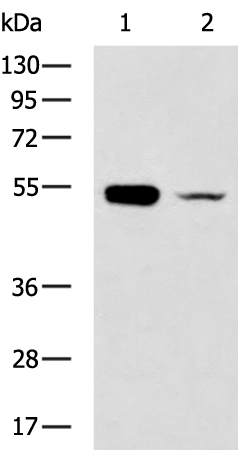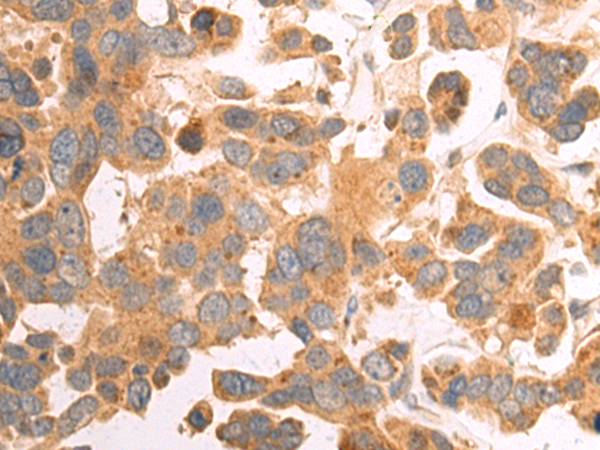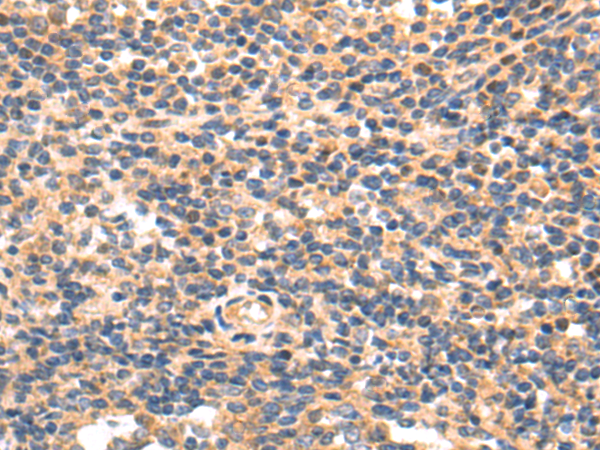


| WB | 咨询技术 | Human,Mouse,Rat |
| IF | 咨询技术 | Human,Mouse,Rat |
| IHC | 1/100-1/300 | Human,Mouse,Rat |
| ICC | 技术咨询 | Human,Mouse,Rat |
| FCM | 咨询技术 | Human,Mouse,Rat |
| Elisa | 1/5000-1/10000 | Human,Mouse,Rat |
| Aliases | CHIT2; AMCASE; TSA1902 |
| WB Predicted band size | 52 kDa |
| Host/Isotype | Rabbit IgG |
| Antibody Type | Primary antibody |
| Storage | Store at 4°C short term. Aliquot and store at -20°C long term. Avoid freeze/thaw cycles. |
| Species Reactivity | Human, Mouse |
| Immunogen | Fusion protein of human CHIA |
| Formulation | Purified antibody in PBS with 0.05% sodium azide and 50% glycerol. |
+ +
以下是关于CHIA(几丁质酶酸性)抗体的3篇参考文献的简要概述:
---
1. **文献名称**:*Chitinase 3-like-1 regulates allergic inflammation and Th2 immune response*
**作者**:Zhou Y, et al.
**摘要**:该研究探讨了CHIA(Chitinase 3-like-1.Chi3l1)在过敏性炎症中的作用,发现其通过调控Th2免疫反应促进气道高反应性和黏液分泌。研究利用CHIA抗体检测其在哮喘模型中的表达,表明抑制CHIA可能成为过敏性疾病的潜在治疗靶点。
---
2. **文献名称**:*Role of acidic mammalian chitinase in parasitic nematode infection*
**作者**:Sutherland TE, et al.
**摘要**:本文研究CHIA在寄生虫感染中的功能,发现其通过降解宿主组织中的几丁质成分增强免疫清除能力。通过CHIA抗体阻断实验,证实CHIA缺失会导致宿主对线虫感染的抵抗力下降,提示其在抗寄生虫免疫中的关键作用。
---
3. **文献名称**:*Acidic mammalian chitinase promotes fibrosis in chronic respiratory diseases*
**作者**:Lee CG, et al.
**摘要**:该文献揭示CHIA在慢性呼吸道疾病(如COPD和肺纤维化)中通过促进纤维化通路激活导致组织重塑。利用CHIA抗体进行组织染色,发现其高表达与疾病严重程度相关,为靶向CHIA的疗法提供了实验依据。
---
如需具体文献全文或更多信息,建议通过PubMed或ResearchGate平台检索标题及作者获取。
The CHIA antibody targets chitinase-3-like protein 1 (CHI3L1), also known as YKL-40. a glycoprotein implicated in inflammatory and fibrotic processes. CHI3L1 is a member of the mammalian chitinase-like protein family, lacking enzymatic activity but retaining chitin-binding properties. It is secreted by macrophages, neutrophils, epithelial cells, and cancer cells, playing roles in tissue remodeling, angiogenesis, and immune regulation. Elevated CHI3L1 levels correlate with chronic inflammatory diseases (e.g., asthma, COPD), fibrosis (liver, lung), and cancers, making it a biomarker for disease progression and prognosis.
CHIA antibodies are primarily used in research to detect CHI3L1 expression in tissues or biological fluids via techniques like ELISA, Western blot, or immunohistochemistry. They help elucidate CHI3L1's mechanisms in pathogenesis, including its interaction with receptors like IL-13Rα2 and Syndecan-1. which activate pro-inflammatory pathways (e.g., MAPK, PI3K/AKT). Recent studies explore therapeutic potential, with CHIA antibodies tested in preclinical models to block CHI3L1 signaling, aiming to mitigate inflammation or tumor growth. However, clinical applications remain investigational, requiring further validation of safety and efficacy. Overall, CHIA antibodies serve as critical tools for understanding CHI3L1's multifunctional roles and developing targeted therapies.
×